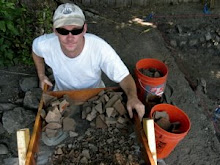I am reviving this blog so that one of my research teams can report on their work. We have been working on a project to solve a puzzle for industrial archaeologists and heritage managers, trying to add a new technique to the conservator's tool box for wrought and cast iron, steel, and other ferrous metal objects.
"Rusting" is the colloquial term for the chemical reactions that decay metal artifacts. Rust causes big problems for archaeologists. When excavating on a site, archaeologists become excited discovering humble artifacts, such as iron nails. While nails aren't as exciting as coins, armor, bullets, rings, buttons, bottles, and the dramatic artifacts featured on TV shows about digging for treasure, but the unassuming nails teach us a great deal about places. Did you know that if you sort out and count the nails according to the way they were manufactured, then by comparing those counts, a researcher can estimate when a building was built? This seems to work, even if the building burned, leaving only a soil layer of ash and charcoal (and lots of nails!).
Of course, for industrial archaeologists, ferrous metals don't just include artifacts that were purchased and used in one place or another, but also includes manufacturing waste. While digging at the West Point Foundry in Cold Spring, New York, our research teams encountered hundreds of gallons of metallurgical waste over the years. Examples ranged from curls of iron cut while rifling cannon barrels, lathing and boring waste from giving cannon precisely smooth surfaces; blacksmithing waste from forging; ferrous tap slag from the blast furnace; discarded sprues, gates, and risers from the casting house; and tons of scrap iron left around the shops for making rods, bolts, spikes, brackets, and all manner of other hardware. This list only includes waste products, not the hundreds of other iron and ferrous metal objects manufactured at that site-- including shells and shot; architectural iron; and machinery parts for example. Most industrial heritage sites have this problem.
These artifacts all teach us a great deal about the past, including issues such as the technical creativity of people at work during their daily lives in the nineteenth century. Yet they present a difficult problem for long term care and storage once the archaeological fieldwork is over. Unlike brass, gold, and aluminum, iron does not stabilize once it has developed it's rusty patina. The process of chemical decay continues underneath the surface rust. Without some intervention, a bag of ferrous metal objects removed from the ground, cleaned and bagged, then put into storage in a controlled environment, continues to decay. After a decade passes, the bag will be full of nodules of corrosion product and rusty dust instead of nails, screws, and hardware.
Conservators and museum staff have several tools available to counter iron's tendency toward chemical decay, but most of them are unsatisfactory for different reasons. My colleagues and I proposed to develop a new technique for stabilization and conservation that will help solve these problems, and we were generously awarded a grant in support of our efforts by the National Park Service's National Center for Preservation Technology and Training.
Over the next few posts, I will introduce our research team members, discuss existing techniques of iron and ferrous metals conservation, the nature of decay, and lay out our proposed technique. If this subject interests you, please stay tuned!
Subscribe to:
Post Comments (Atom)

No comments:
Post a Comment